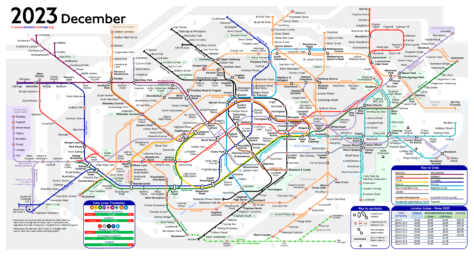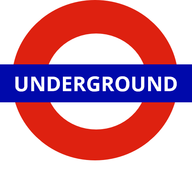London Underground, officially known as “London Underground” and commonly as “The Tube”, is the underground transport system that operates in the capital of the United Kingdom. Inaugurated on 10 January 1863, It is the oldest subway in the world.
It has 11 lines that cover 402 kilometres (about 250 miles) y 272 stations, making it a vital part of the daily mobility of millions of residents and tourists in the city.
Map of Tube
Here's the london tube map, click on the image to see it larger:

We've taken the map from londontubemap.org, They update the map frequently:
Official Web site
For more information, you can visit these websites:
- Unofficial London Underground website (better and easier to use).
- London Underground official website.
- List of all tourist attractions in London.
Schedules
day service
Weekdays and Saturdays:
- Most lines operate from 5:00 until the 1:00 the next day.
Sundays:
- Service generally begins at 7:00 and it ends at 23:30.
Night service (Night Tube y Night Overground)
Night service is only available on Fridays and Saturdays on the following lines:
Night Tube:
- Line Central: In between Ealing Broadway y Loughton / Hainault.
- Line Jubilee: All along the line.
- Line Northern: In between Morden y High Barnet / Edgware.
- Line Piccadilly: In between Cockfosters y Heathrow Terminal 5.
- Victoria Line: All along the line.
Night Overground:
- East London Line: In between Highbury & Islington y New Cross Gate.
These services operate approximately every 10 minutes in the center and every 20 minutes in the most remote areas.
London Underground fares
Below is a summary table with the main prices in pounds sterling (GBP), along with information about special cards and discounts.
Rates table
| Zone(s) | Simple Rate (Peak) | Simple Rate Oyster (Off-Peak) | Rate with Oyster (Peak) | Rate with Oyster (Off-Peak) | Daily Rate (Oyster) |
|---|---|---|---|---|---|
| Zone 1 | £6.70 | £2.80 | £2.80 | £2.70 | £8.50 |
| Zone 1-2 | £6.70 | £3.40 | £3.40 | £2.80 | £8.50 |
| Zone 1-3 | £6.70 | £3.70 | £3.70 | £3.00 | £10.00 |
| Zone 1-4 | £6.70 | £4.40 | £4.40 | £3.20 | £12.30 |
| Zone 1-5 | £6.70 | £5.10 | £5.10 | £3.50 | £14.60 |
| Zone 1-6 | £6.70 | £5.60 | £5.60 | £3.60 | £15.60 |
| Zone 1-9 | £9.80 | £7.90 | £7.90 | £4.80 | £15.60 |
On the London Underground, “Peak Time” (rush hour) y “No-peak schedule” (off-peak) refer to the different times of the day when there are more or fewer passengers using the subway:
| Schedule Type | Description | Typical Time |
|---|---|---|
| Peak | Many people, higher prices. | Monday to Friday: 6:30-9:30 AM, 4:00-7:00 PM |
| No-Peak | Less people, lower prices. | Out of hours Peak, including nights and weekends. |
This table above, shows in a simple way when the schedules are Peak y No-Peak on the London Underground and what you can expect on each one.
Special cards and discounts
- Oyster Card: It is a prepaid card that offers cheaper rates compared to paper tickets. It can be recharged with credit and has a daily limit that controls the maximum spending:
- Card cost: £5.00 (non refundable).Daily limit for zones 1-2: £8.50 ($11.00 USD). Card cost: £5.00 (non refundable).Daily limit for zones 1-2: £8.50 ($11.00 USD).
- Card cost: £5.00 (non refundable).
- Daily limit for zones 1-2: £8.50 ($11.00 USD).
- Travelcards: These cards allow unlimited travel within selected areas and are available for different periods:
- Travelcard daily (zones 1-2): £15.90 ($20.60 USD).
- Travelcard weekly (zones 1-2): £42.70 ($55.30 USD).
- Travelcardmonthly (zones 1-2): £183.00 ($237.20 USD).
- Contactless Payment: Use a bank card contactless offers the same advantages as a Oyster Card, including daily limits.
- Discounts for Tourists: There are special cards for tourists, as the Visitor Oyster Card, which can be purchased before arriving in London and comes with preloaded credit. Besides, minors 11 years old travel for free and children 11 a 15 years can get reduced rates.
- Hopper Fare: Allows unlimited bus and tram journeys within one hour for £1.75 ($2.30 USD).
For more details and to purchase cards, you can visit the Transport for London official site.
History of the London Underground

London Underground, Affectionately known as “The Tube“, It has a history dating back to the 19th century.
It all started on 10 January 1863 with the opening of the Metropolitan Railway, the first underground line in the world, that united Paddington (Bishop’s Road) con Farringdon Street. This project was a response to the increasing traffic on London streets. The construction was carried out using the method of “cut-and-cover“, where trenches were dug along the streets and covered with brick or steel roofs.
Early expansion
The Metropolitan Railway quickly expanded its services, arriving to Hammersmith in 1864 y Richmond in 1877, using the routes of London and South Western Railway. During the following years, new extensions came to Swiss Cottage in 1868, Harrow in 1880 and finally Chesham in 1889.
Emergence of new lines
In 1868, was inaugurated District Railway which initially operated between South Kensington y Westminster. This line expanded rapidly westward, arriving to Hammersmith in 1874 already Ealing Broadway in 1879. For 1884, the connection between Metropolitan and the District Railway completed what we know today as the Circle Line.
The electrical age
A crucial milestone was the opening in 1890 of the City and South London Railway, the world's first deep, electrified underground line. This line, what was about King William Street a Stockwell, It was designed by the engineer James Henry Greathead, who used an innovative excavation method with compressed air and iron coating.
20th century and new technologies
The 20th century brought with it the electrification of several lines. The Central London Railway, Also known as “Twopenny Tube“, opened in 1900, and in 1906 the lines were inaugurated Bakerloo y Piccadilly. The Waterloo and City Railway was added in 1898 to connect Waterloo with the financial center of the city.
In 1933, most metro lines were unified under public administration, ushering in a new era of management and expansion. During world war II, subway stations became bomb shelters, protecting thousands of Londoners from bombings.
Modern expansion
The opening of the line Victoria in 1968 and of the Jubilee in 1979 marked important expansions in the network. The Victoria line was the first to be automatically controlled, which represented a great technological advance. In 1987, the line extension was inaugurated Piccadilly to the airport Heathrow, facilitating access to one of the busiest airports in the world.
History of the London Underground Map
Before 1930: The First Maps
Originally, London Underground maps from 1863, were detailed geographical representations, focusing on the precise relationship between stations and surface streets. From 1908, The various metro lines were shown together on a single map. However, These early maps were confusing and difficult to read due to their excessive level of detail..
1931-1959: Harry Beck and his revolution
Harry Beck, a signal technician for the subway company, introduced a radical change in 1931. Inspired by the electrical diagrams he used in his daily work, Beck designed a schematic map that greatly simplified the metro network. This design represented the lines and stations using straight horizontal lines., vertical and diagonal 45 degrees, using distinctive colors for each line and clear symbols for stations and interchanges. Although it was initially rejected for being too innovative, was finally accepted in 1933 and became an immediate success, transforming the traveler experience and setting a new standard for transportation maps globally.
1960-1985: Changes and restorations
In 1960, Harold Hutchison, a subway publicity officer, presented a new version of the map without consulting Beck. This version introduced sharper angles and more square interchange shapes, which resulted in a less popular design with the public and itself Beck. In 1964, Paul Garbutt took control of map design, restoring many of the original elements of Beck but maintaining some changes introduced by Hutchison, like the trading circles in black. Garbutt He continued to oversee the map's design for at least two more decades, gradually adapting it to include new lines and services such as Docklands Light Railway and the London Overground, and adding accessibility elements such as indications for people who use wheelchairs.
Recognition and Legacy
Although Harry Beck He did not receive the recognition he deserved in life, His contribution has been widely recognized in recent years. From 1997, Each London Underground map includes a mention of Beck, recognizing its original design 1931 as the base of the current map. The last significant map update was a collaboration with the Royal Academy of Engineering to highlight the impact of engineering on the structure and functioning of London, and to promote careers in science, technology, engineering and mathematics (STEM).
Additional data
The London Underground is essential to reach the most important tourist places such as:
Most important tourist places in London
- Tower of London (Tower Hill, line Circle y District): Discover the rich history of this iconic castle, home of the Crown Jewels.
- The London Eye (Waterloo, line Jubilee): Enjoy stunning panoramic views of the city from this famous Ferris wheel.
- British museum (Tottenham Court Road, line Central y Northern): Explore art and antique collections from around the world, including the stone Rosetta.
- Palace of Buckingham (Green Park, line Piccadilly): Visit the official residence of the British monarchy and watch the Changing of the Guard.
- Abbey of Westminster (Westminster, line Circle, District y Jubilee): Admire the Gothic architecture of this historic royal coronation and burial site.
- National Gallery (Charing Cross, line Bakerloo y Northern): See masterpieces of European painting, from the Renaissance to the 19th century.
- Museum of Natural History (South Kensington, line Piccadilly, Circle y District): Marvel at dinosaur exhibits and the enormous blue whale at this fascinating museum.
- Tate Modern (Blackfriars, line Circle y District): Immerse yourself in modern and contemporary art inside this former power station.